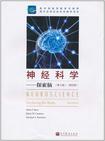神经科学
2011-2-1
高等教育出版社
Mark F. Bear,Barry W. Connors,Michael A. Paradiso
无
《教育部高等教育司推荐国内外优秀生命科学教学用书•神经科学:探索脑(第3版)(影印版)》分为Foundations、Sensory and Motor Systems、The Brain and Behavior、The Changing Brain四部分。Neuroscience: Past, Present, and Future、The Neuronal Membrane at Rest、The Structure of the Nervous System等内容。教育部高等教育司推荐,国外优秀生命科学教学用书。《教育部高等教育司推荐国内外优秀生命科学教学用书•神经科学:探索脑(第3版)(影印版)》突出实用性、及时性与系统性。
作者:(美国)贝尔(Mark F.Bear) (美国)柯勒斯(Barry W.Connors) (美国)帕罗蒂斯(Michael A.Paradiso)
Preface vii User's Guide xiii Acknowledgments xviii Path of Discovery Authors xix Part Ⅰ Foundations I Chapter 1 Neuroscience: Past, Present, and Future Chapter 2 Neurons and Glia Chapter 3 The Neuronal Membrane at Rest Chapter 4 The Action Potential Chapter 5 Synaptic Transmission Chapter 6 Neurotransmitter Systems Chapter 7 The Structure of the Nervous System Appendix: An Illustrated Guide to Human Neuroanatomy Part Ⅱ Sensory and Motor Systems Chapter 8 The Chemical Senses Chapter 9 The Eye Chapter 10 The CentralVisual System Chapter 11 The Auditory and Vestibular Systems Chapter 12 The Somatic Sensory System Chapter 13 Spinal Control of Movement Chapter 14 Brain Control of Movement Part Ⅲ The Brain and Behavior Chapter 15 Chemical Control of the Brain and Behavior Chapter 16 Motivation Chapter 17 Sex and the Brain Chapter 18 Brain Mechanisms of Emotion Chapter 19 Brain Rhythms and Sleep Chapter 20 Language Chapter21 Attention Chapter 22 Mentallllness Part Ⅳ The Changing Brain Chapter 23 Wiring the Brain Chapter 24 Memory Systems Chapter 25 Molecular Mechanisms of Learning and Memory Glossary References and Resources Index
版权页: 插图: are electrically charged particles. Consider the situation in Figure 3.9, where wires from the two terminals of a battery are placed in a solution containing dissolved NaCl. Remember, opposite charges attract and like charges repel. Consequently, there will be a net movement of Na+ toward the negative terminal (the cathode) and of Cl- toward the positive terminal (the anode). The movement of electrical charge is called electrical current, represented by the symbol I and measured in units called amperes (amps). According to the convention established by Benjamin Franklin, current is defined as being positive in the direction of positive-charge movement. In this example, therefore, positive current flows in the direction of Na+ovement,from the anode to the cathode. Two important factors determine how much current will flow: electrical potential and electrical conductance. Electrical potential, also called voltage, is the force exerted on a charged particle, and it reflects the difference in charge between the anode and the cathode. More current will flow as this difference is increased. Voltage is represented by the symbol V and is measured in units called volts. As an example, the difference in electrical potential between the terminals of a car battery is 12 volts; that is, the electrical potential at one terminal is 12 volts more positive than that at the other. Electrical conductance is the relative ability of an electrical charge to migrate from one point to another. It is represented by the symbolg and measured in units called siemens (S). Conductance depends on the number of particles available to carry electrical charge and the ease with which these particles can travel through space. A term that expresses the same property in a different way is electrical resistance, the relative inability of an electrical charge to migrate. It is represented by the symbol R and measured in units called ohms (Ω). Resistance is simply the inverse of conductance (i.e., R = l/g). There is a simple relationship between potential (V), conductance (g),and the amount of current (I) that will flow. This relationship, known as Ohm's law, may be written I = gV: Current is the product of the conductance and the potential difference. Notice that if the conductance is zero, no current will flow even when the potential difference is very large. Likewise, when the potential difference is zero, no current will flow even when the conductance is very large. Consider the situation illustrated in Figure 3.10a, in which NaCl has been dissolved in equal concentrations on either side of a phospholipid bilayer. If we drop wires from the two terminals of a battery into the solution on either side, we will generate a large potential difference across this membrane. No current will flow, however, because there are no channels to allow migration of Na+ and Cl- across the membrane; the conductance of the membrane is zero. Driving an ion across the membrane electrically, therefore, requires that (1) the membrane possesses channels permeable to thation, and (2) there is an electrical potential difference across the membrane (Figure 3.10b).
《教育部高等教育司推荐国内外优秀生命科学教学用书•神经科学:探索脑(第3版)(影印版)》由高等教育出版社出版。

无
以前买过第二版的中文版,挺好的一本书,通俗易懂,琅琅上口!
帮同学买的,教材,装帧赞
不是彩图,但是在网上可以下载彩图,不错!
书是不错的,就是在快递过程中,书页有压痕、折痕。
因为平日里经常要做好长时间的公交车,打算找个神经学的书看看,手机不支持PDF,所以想找个TXT完整版的。要是买书的话根据各位所述好像是买不到了,也舍不得买书。不过对于神经学还是挺感兴趣的,毕竟这一块我还没有探索过,很是好奇
如果你不是学者专业的真没必要看,特别是第五章开始你更不会想看的
LZ 啊,这书也只看 TXT 吗?玩笑开得有点儿大了吧……
浏览了一下,还没有认真看,真的很专业!!希望自己能看下去。。
这种生物类的专业书要是不看图,等于白看。
nidayede